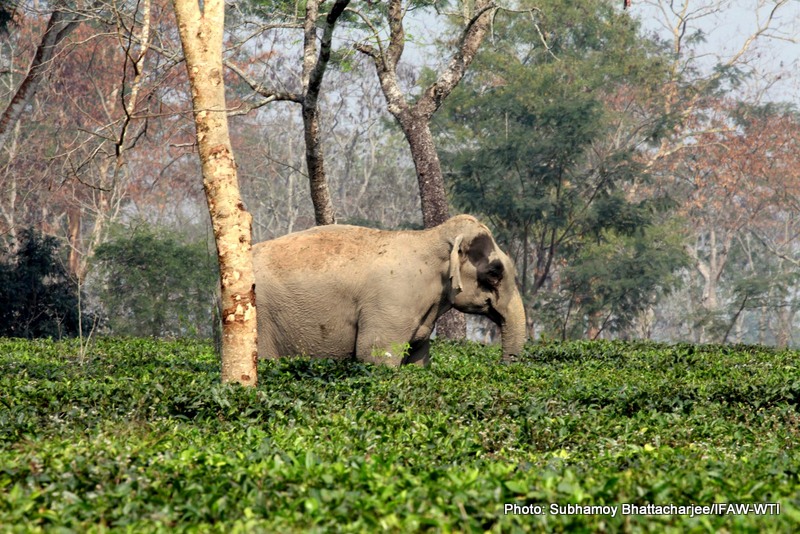Crowd Control Enables Elephant Rescue her Calf in a Tea Garden in Assam
Golaghat, Assam, 24 February 2016: It was a happy ending for an elephant calf that was unable to cross a tea garden ditch in Assam, where the IFAW-WTI team managed to control a crowd and enable the mother elephant to ‘rescue’ her calf. The basic principles of wildlife conservation and welfare came to the fore when the calf walked away with its mother into the wild without human intervention and with judicious crowd management.
Tea garden workers moving away from the site to let the elephant have her space
The tea pluckers of Lokhoojan Tea garden were getting ready for work this Tuesday morning when they heard an elephant trumpet at a distance on the southern side of the tea garden.
Finding elephants in the tea gardens is not a new phenomenon for these workers as they are accustomed to seeing wild elephant herds that cross the tea gardens from Karbi Anglong hills to Nambor Reserve Forest. But this trumpeting was unusual. It belonged to a solitary mother elephant who was throwing mud around and seemed in distress.
The distressed mother elephant in the tea garden
The area is not far from the tea pluckers’ colony on the edge of the tea garden. The tea garden is separated into two hillocks by a low lying paddy field in between. The elephant was visible on top of the southern block of the garden. Her distressed behavior clearly indicated the presence of a calf in crisis. It is usual for young elephants to get stuck in tea garden trenches in Assam and this could well be one such situation. Tea garden trenches account for about a third of the young calves that get displaced in Assam.
Honorary Wildlife Warden of Kaziranga Uttam Saikia, sought the help of the IFAW-WTI team at the conveniently located Centre for Wildlife Rehabilitation and Conservation (CWRC) in Kaziranga.
On reaching the site, the IFAW-WTI team found the mother elephant desperately trying to get her calf across a deep trench that cut the tea garden off from the forest. The calf was barely a few weeks old and unable to cross on its own.
As the news spread, the tea garden turned into a hub of human activity after people working in the vicinity turned up to watch the spectacle. This posed the biggest problem for the mother elephant that was trying to protect her calf and was looking for a safe passage to the forest.
The mother elephant trying to loosen soil from the trench using her head
In such situations crowd management is the only tool to provide a safe passage to wildlife to enable them to freely leave the place without conflict with humans. It was thus imperative to keep the crowd away and enable the elephant to use her wild instincts.
The trench as seen a day after, showing evidence of the elephant’s work
Seeing the condition of the stranded mother and calf, the IFAW-WTI team, with support of the forest department and the tea garden management, convinced the local enthusiasts to leave the place to give a safe passage to the elephant and her calf.
Success! The little calf managed to step across the trench, partially filled in by the mother
“Once the crowd dispersed at a safe distance, we saw the mother started to fill up the trench with soil and branches so that she could take the baby out of the scene. She continued this till afternoon and we were elated to see her walk into the forest with her calf,” said Panjit Basumatary, IFAW- WTI veterinarian who was on standby for any clinical help.
Several instances of human elephant conflict situations are known in which elephants are disturbed by crowds or chased around before they lose direction and cause more conflict. The pragmatic approach would be to ensure that the elephants are headed back on the right course, ideally by facilitating their exit and keeping human interventions to a minimum.
